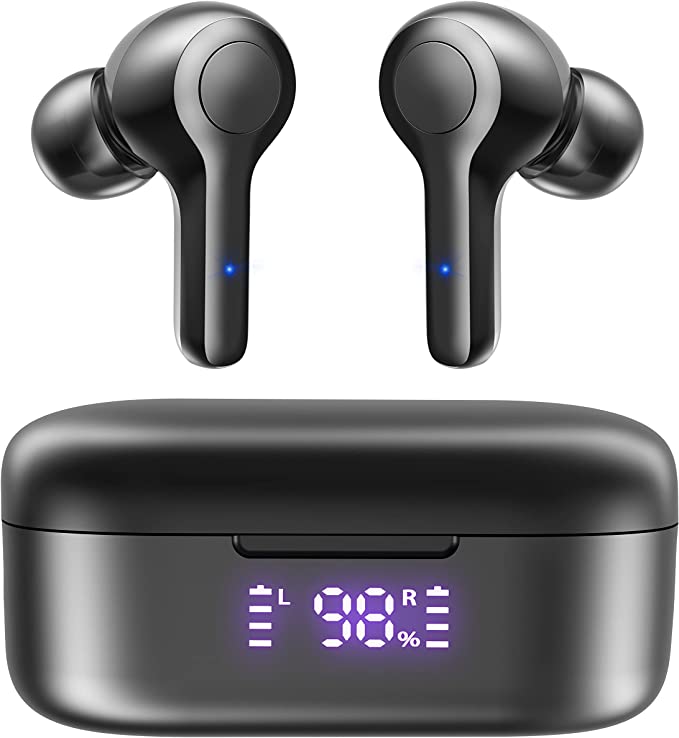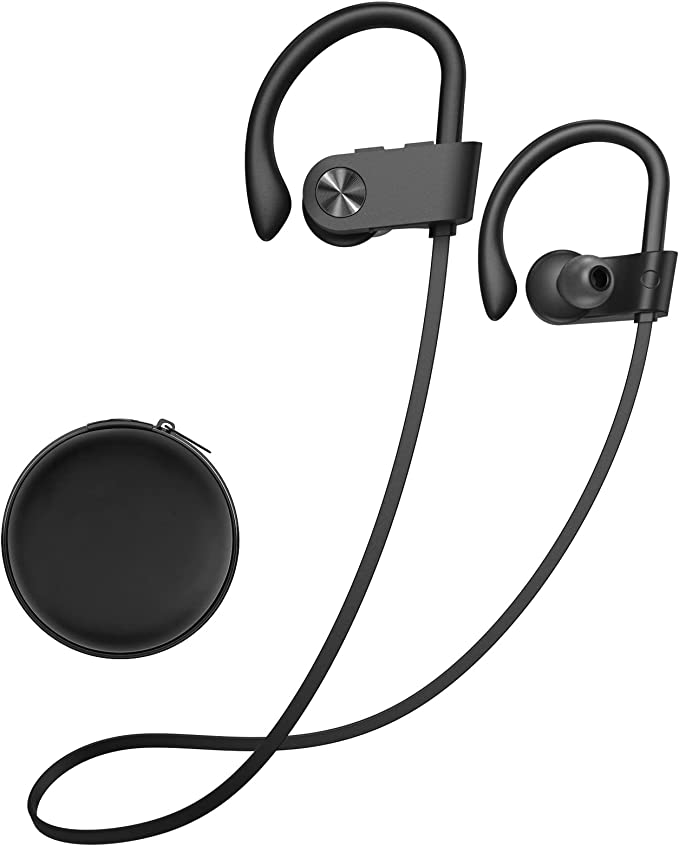We live immersed in a world of sound, yet increasingly, we experience it untethered. Tiny wireless earbuds, nestled comfortably in our ears, seem almost magical – conjuring music, connecting us through calls, or cocooning us in focus, all without a physical leash to our devices. It feels effortless, almost second nature. But behind this seamless experience lies a fascinating tapestry of science and engineering, constantly evolving to deliver better performance, clarity, and convenience.
Let’s pull back the curtain. While countless options exist, we can use a specific, accessible example like the MOZOTER DBK02 Bluetooth 5.3 Wireless Earbuds not for a conventional review, but as a lens. A window through which we can explore the fundamental technologies that power the modern wireless audio experience. Forget the marketing jargon for a moment; let’s delve into the how and why with an expert’s eye, understanding the principles that allow these compact devices to perform their daily magic.

The Invisible Tether: Decoding Bluetooth 5.3’s Promise
The very foundation of any wireless earbud is its connection to your phone, laptop, or tablet. This invisible handshake is typically managed by Bluetooth technology. The DBK02 earbuds utilize Bluetooth 5.3. Now, version numbers might seem like incremental updates, but each iteration of the Bluetooth standard aims to refine this crucial link. Compared to its predecessors like Bluetooth 5.0, the Bluetooth 5.3 standard was designed with enhancements focused on efficiency (potentially leading to better battery life for connected devices), connection stability (less chance of annoying dropouts or stutters), and improved handling of wireless traffic, especially in crowded environments.
Think of the radio waves used by Bluetooth like lanes on a highway. Newer versions often implement smarter ways to navigate this highway, finding clearer paths and using the lanes more efficiently to avoid interference from other wireless devices (like Wi-Fi routers or even microwave ovens) that share the same general frequency bands (around 2.4 GHz). The goal is a smoother, more reliable journey for your audio data.
Making this connection useful requires more than just a link; it needs specific communication protocols, often represented by acronyms like HSP, HFP, A2DP, and AVRCP, all of which are supported by the DBK02 according to its specifications. Let’s quickly demystify them:
* HSP (Headset Profile) and HFP (Hands-Free Profile) are the workhorses for phone calls, managing the two-way audio and basic call controls.
* A2DP (Advanced Audio Distribution Profile) is the key that unlocks high-quality stereo music streaming from your device to the earbuds.
* AVRCP (Audio/Video Remote Control Profile) allows you to use the controls on your earbuds (like play, pause, skip track) to command the media player on your phone or computer.
The product information also highlights “One-Step Pairing.” This isn’t a unique technology but rather a user-friendly implementation built upon these standard Bluetooth protocols. The aim is that after the initial setup, the earbuds automatically connect to your known device simply by opening the charging case lid – a small convenience that significantly smooths out the daily user experience.

Crafting Your Personal Soundscape: Drivers, Acoustics, and the Crucial Role of Fit
Once connected, how do these tiny devices actually produce sound? At their core are the drivers – essentially miniature speakers. The MOZOTER DBK02 employs 8mm dynamic drivers. A dynamic driver works much like its larger loudspeaker cousins: an electrical audio signal passes through a voice coil attached to a diaphragm (a thin membrane). This coil sits within a magnetic field. The interaction between the electrical signal and the magnetic field causes the coil and diaphragm to vibrate rapidly, pushing air and creating the sound waves that travel down your ear canal to your eardrum.
Does driver size matter? An 8mm driver is reasonably substantial for an earbud. Generally, a larger diaphragm can move more air, which often translates to a greater potential for reproducing lower frequencies (bass). However, driver size alone doesn’t guarantee good sound. The quality of the driver materials, the precision of its construction, and, crucially, the acoustic tuning – how the engineers shape the sound signature using the earbud’s internal design and digital processing (if any) – play a far more significant role.
The product description mentions a “4-sound chamber design.” Without detailed schematics, it’s hard to say precisely what this entails. However, in acoustic engineering, internal chambers and pathways within an enclosure (like an earbud shell) are often used to manage airflow, control resonances, and shape the frequency response – essentially fine-tuning the raw sound produced by the driver. It could be a contributing factor to achieving the claimed “powerful heavy bass, ultra-clear vocals, and wonderful treble,” but its specific impact is difficult to assess from the description alone.
Perhaps the most overlooked aspect of earbud audio is fit. This is where ergonomics and the provided eartips (in Small, Medium, and Large sizes for the DBK02) become paramount. Achieving a good acoustic seal between the eartip and your ear canal does two critical things:
1. Passive Noise Isolation: It physically blocks a significant amount of external ambient noise from reaching your eardrum, allowing you to listen at lower volumes and improving focus.
2. Bass Response: Low-frequency sound waves require this seal to build pressure effectively within the ear canal. A poor seal lets bass ‘leak’ out, resulting in thin or weak-sounding audio, regardless of how capable the driver is.
Finding the right eartip size isn’t just about comfort (though that’s vital too); it’s fundamental to experiencing the earbuds’ intended sound quality. It’s a form of personalized acoustics, adapting the device to your unique ear geometry.

Voices Through the Void: Understanding ENC for Clearer Calls
Wireless earbuds aren’t just for music; they’re vital communication tools. But making clear calls in noisy environments – a busy street, a bustling cafe, a windy park – is a significant technical challenge. Your earbud microphones inevitably pick up not just your voice, but all the surrounding chaos. This is where technologies like ENC (Environmental Noise Cancellation) come into play, as featured in the DBK02 with its four-microphone array (two per earbud).
It’s crucial to understand what ENC aims to do, and how it differs from the perhaps more widely known ANC (Active Noise Cancellation). According to the product details, the ENC here aims to “reduce 90% of the ambient noises and enhance your voice during phone calls.” The key phrase is “during phone calls” – ENC primarily focuses on cleaning up the audio signal sent from your microphones to the person on the other end of the call.
How does it generally work? While specific algorithms vary, multi-microphone ENC systems typically leverage a principle similar to beamforming. By using the slight time differences and intensity variations of sound arriving at the multiple microphones, the system can computationally create a ‘listening beam’ directed towards your mouth, amplifying sounds originating from that direction (your voice). Simultaneously, it identifies sounds coming from other directions as ambient noise and attempts to subtract or suppress them from the outgoing signal. Think of it like a sonic spotlight focusing on your voice while trying to dim the surrounding noise for your listener.
This makes ENC fundamentally different from ANC (Active Noise Cancellation). ANC uses microphones to listen to the external noise reaching the earbud, then generates an ‘anti-noise’ sound wave (180 degrees out of phase) that cancels out the incoming noise before it reaches your eardrum, creating a quieter listening experience for you. ENC cleans your transmitted voice; ANC quiets your world. They solve different problems using different techniques.
While the claim of “90% reduction” is a specific marketing figure, the effectiveness of any ENC system in the real world depends heavily on the type and level of background noise, the quality of the microphones, and the sophistication of the noise reduction algorithms. It’s a complex signal processing task, aiming to make your voice intelligible above the din.

The Power Equation: Endurance, Charging, and Smart Design
All this wireless technology needs power. Earbuds rely on compact Lithium-Ion (Li-Ion) batteries, known for their high energy density (packing a lot of power into a small, light package). The MOZOTER DBK02 specifications state up to 6 hours of listening time from a single earbud (likely in mono mode or under specific test conditions) and a total of up to 36 hours of playtime when factoring in the recharges provided by the carrying case. These figures give a practical sense of endurance – the 6 hours covers most commutes or workout sessions, while the 36 hours means you might go several days, or even a week, between needing to charge the case itself, depending on your usage patterns.
Keeping track of that case charge is simplified by the LED digital display on the DBK02’s case. This provides a percentage readout of the case’s remaining battery, eliminating the guesswork often involved with simple indicator lights. It’s a small but genuinely useful feature for managing power.
When the case does need recharging, it utilizes a Type-C port. This has become the modern standard, largely replacing older micro-USB ports due to its reversible design (no more fumbling to plug it in the right way) and its support for potentially higher power delivery rates. The DBK02 also boasts fast charging, claiming that just 15 minutes connected to power can yield 1 hour of listening time. This is incredibly handy for those moments you realize your earbuds are dead just before heading out – a quick top-up provides enough juice for a short trip or call. A full charge for the case itself is stated to take about 1.5 hours.

Living with the Tech: Ergonomics, Control, and Comfort
Beyond the internal electronics, the physical design – the ergonomics – dictates how comfortable and practical the earbuds are to use daily. As mentioned, achieving a good fit is crucial for sound and isolation. The “ergonomic design” aims to conform naturally to the shape of the outer ear, providing stability without undue pressure. The inclusion of multiple eartip sizes acknowledges that ears are highly individual, allowing users to tailor the fit.
The lightweight nature of the earbuds (combined weight with case listed as 1.69oz/48g) also contributes to long-term comfort, reducing the feeling of bulk or fatigue during extended wear.
Interaction is handled via touch controls on the earbuds themselves. The specifications list standard functions: tap once for play/pause, double-tap right/left for next/previous track, long-press right/left for volume up/down, and triple-tap for activating the connected phone’s voice assistant (like Siri or Google Assistant). This allows for quick adjustments without needing to pull out your phone, which is particularly useful during exercise or when your hands are otherwise occupied. The ability to use either earbud independently (solo mode) adds further flexibility for calls or situations where you need to maintain awareness of your surroundings.

Conclusion: Technology Demystified, Experience Understood
Our journey through the MOZOTER DBK02 has taken us from the invisible radio waves of Bluetooth 5.3 ensuring a stable connection, to the miniature vibrating engines of the 8mm drivers crafting sound waves, the intelligent filtering of ENC striving for call clarity amidst noise, the efficient energy storage of Li-Ion batteries providing hours of freedom, and the critical interface of ergonomic design ensuring comfort and proper function.
What becomes clear is that even accessible, everyday technology like these earbuds relies on a remarkable convergence of scientific principles and clever engineering solutions. Understanding these underlying concepts – how Bluetooth standards evolve, the basics of acoustics and drivers, the different approaches to noise management, the characteristics of modern batteries – does more than just satisfy curiosity. It empowers us as users. It helps us appreciate the intricate design choices involved, allows us to better interpret specifications, manage our expectations, and ultimately, make more informed decisions about the technology we integrate into our lives.
The “magic” of wireless audio isn’t magic at all. It’s applied science, constantly being refined and, thankfully, becoming increasingly understandable and available to us all.




